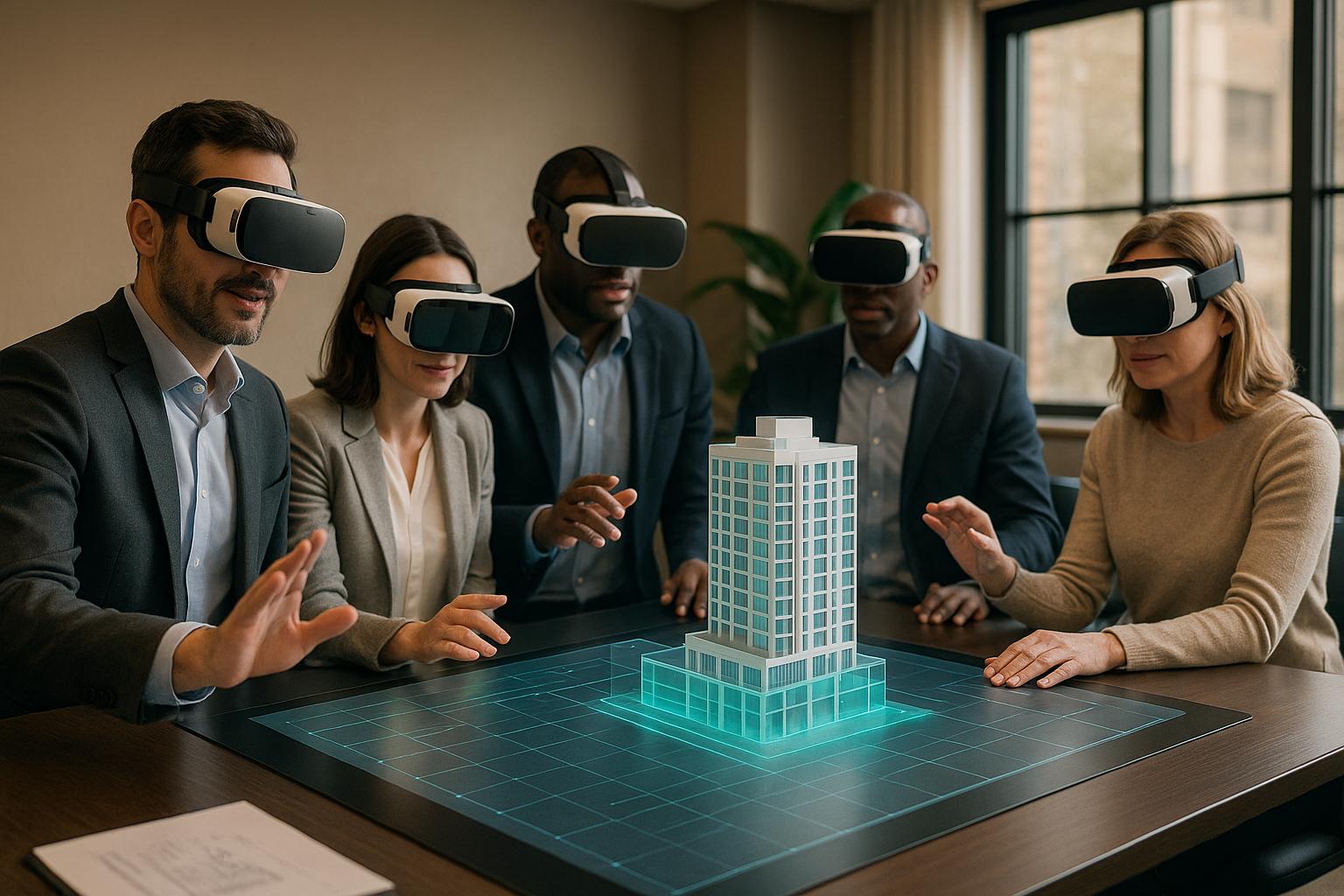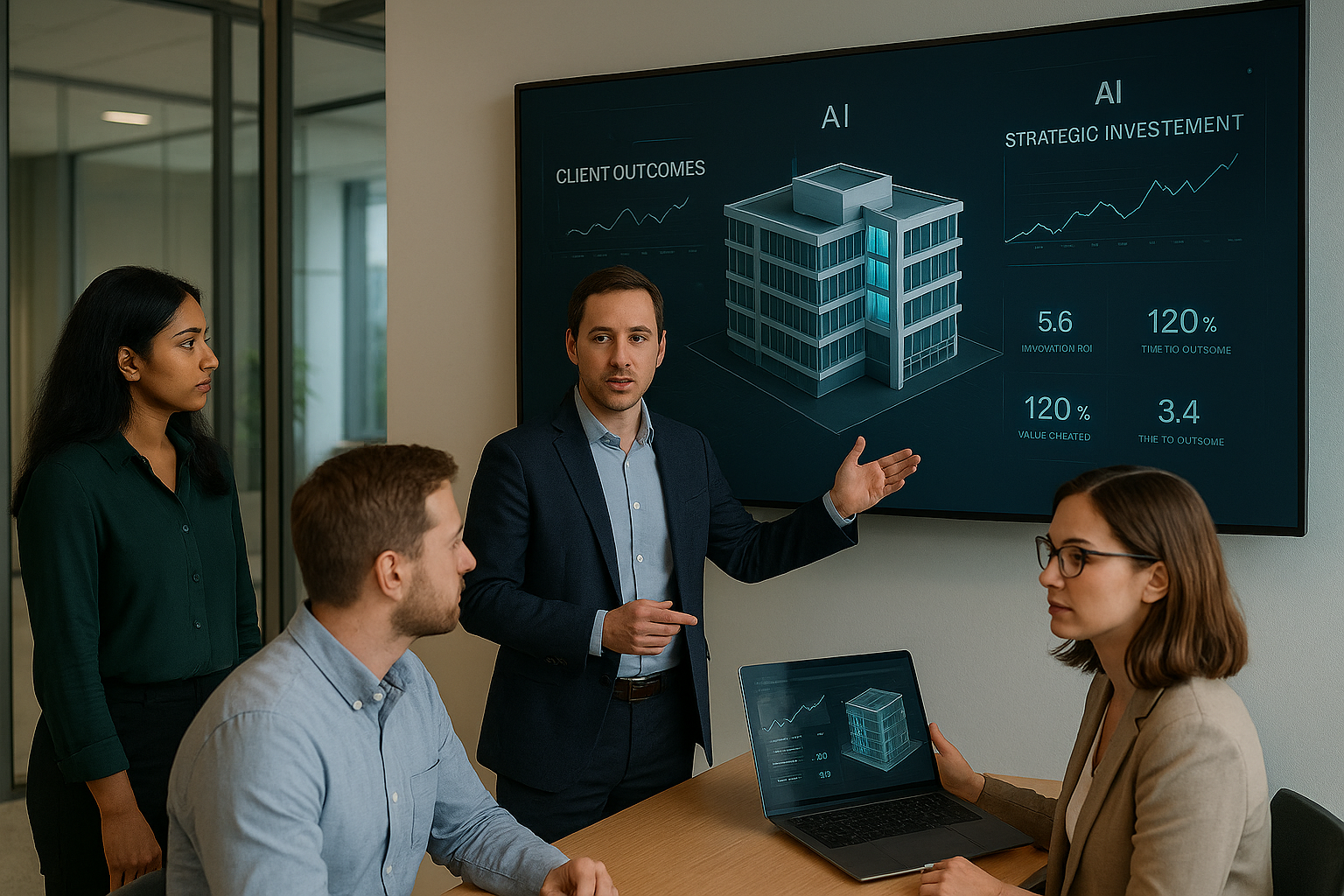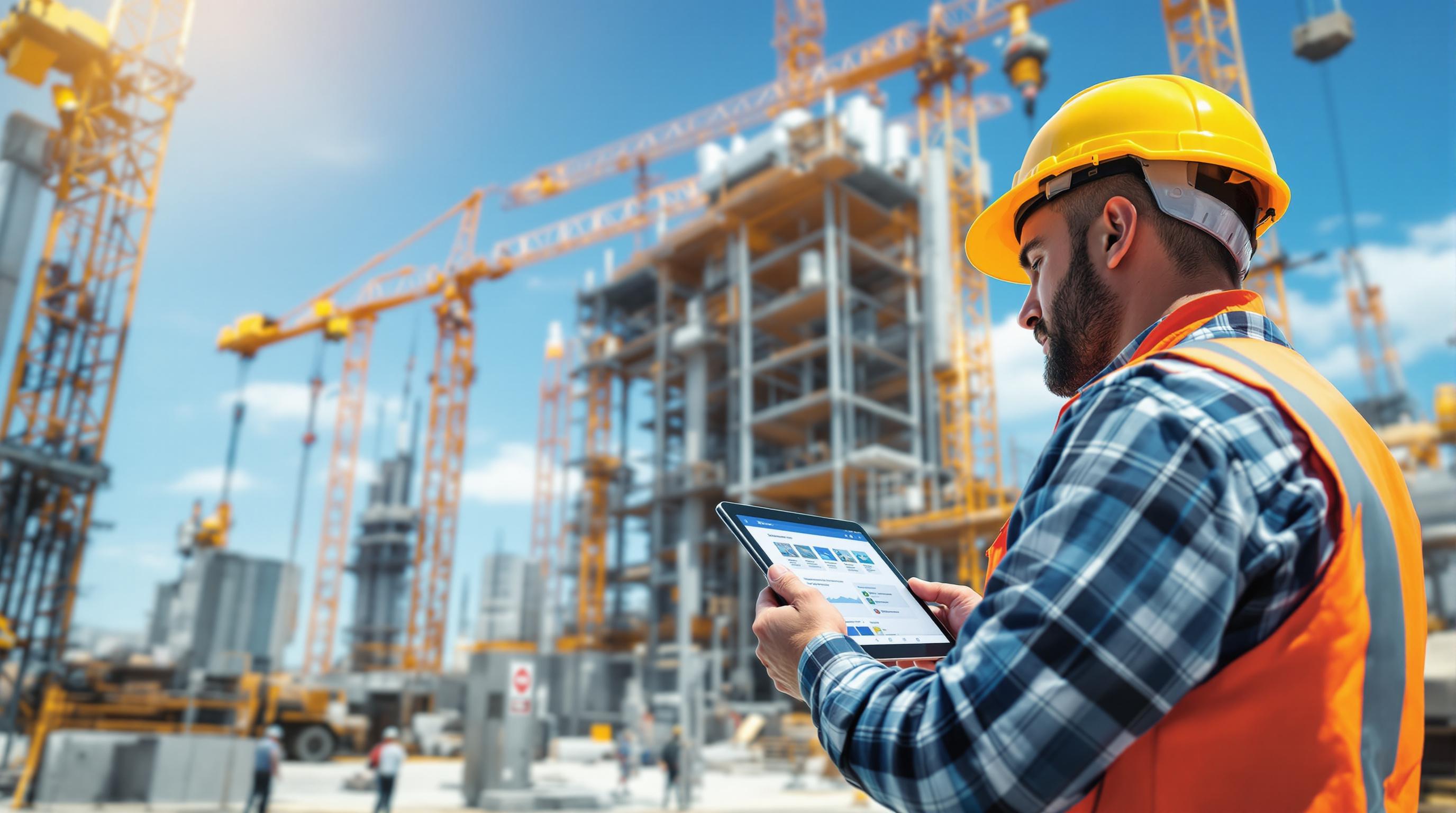VR/AR Applications Transforming Client Presentations for Construction Projects
Taher Pardawala May 16, 2025
VR and AR are changing how construction projects are presented. These technologies let clients virtually walk through spaces, see instant design changes, and collaborate remotely – before construction even starts.
Key Benefits:
- Virtual Walkthroughs: Explore projects in 3D before building begins.
- Instant Design Updates: Make real-time changes to layouts, materials, and lighting.
- Remote Collaboration: Connect teams and clients from anywhere.
- Cost Savings: Cut mock-up expenses by up to 90% and reduce rework costs.
Companies like Layton Construction and Fortis have saved millions using VR/AR. With adoption growing and the market expected to hit $46.6 billion by 2025, these tools are becoming essential for construction professionals.
VR/AR Benefits for Construction Presentations
3D Space Visualization
Virtual Reality (VR) and Augmented Reality (AR) are transforming how clients experience construction designs before a single brick is laid. Research indicates that people exploring VR spaces show a 10% improvement in spatial understanding compared to traditional 2D floor plans [6].
Take the example of Foster + Partners during their work on the Bloomberg European Headquarters. They used VR walkthroughs to fine-tune design decisions [8]. Similarly, in December 2024, BSBG leveraged VR technology to present a luxury hotel project in Sharjah, giving clients the chance to virtually explore spaces and materials firsthand [5].
"By utilizing these technologies, clients can gain an understanding of how the end product will look and feel within a given space and scale." – Brennan Gerle, Director of Creative & Technology, Small Giants [7]
These immersive experiences don’t just enhance visualization but also pave the way for instant feedback and collaborative decision-making.
Instant Design Updates
One of the standout features of VR/AR is the ability to make real-time design updates during meetings. Teams can adjust layouts, swap materials, or tweak lighting while stakeholders watch, cutting down on lengthy revision cycles.
For instance, Skanska’s use of AR technology shortened project timelines by 7% and increased on-site productivity by up to 25% [3]. This kind of adaptability ensures stakeholders are actively involved in decision-making throughout the project lifecycle.
But the benefits of VR/AR don’t stop at real-time design changes – they also bridge the gap between teams located in different parts of the world.
Remote Team Collaboration
VR/AR tools excel at connecting geographically dispersed teams through real-time design reviews, virtual site walkthroughs, and instant expert consultations.
During the pandemic, CRB utilized Microsoft HoloLens to help a U.S.-based client remotely inspect European equipment. Within just 90 minutes, they created an interactive environment for witnessing and feedback [9]. Similarly, the Nova Hospital project showcased how VR, combined with BIM models, allowed hospital staff to provide direct input on design elements before construction even began [4].
"AR has the massive potential to bring the rich information that typically stays in the office to the field. By leveraging 3D models in the field, teams can walk the projects, and ensure constructability and maintainability without having to wait for a designer to be brought on site. The key is to integrate AR seamlessly with communication processes to maintain effective collaboration without the traditional silos and disconnects between the office and field." – Kelly Barber, Division Chief, Systems Management, Pennsylvania Department of Transportation [1]
Collaboration is key, and the numbers back it up – 91% of contractors and owners agree that better collaboration significantly reduces project risks [10]. VR/AR is proving to be a game-changer in breaking down barriers and ensuring smoother workflows.
Main VR/AR Tools in Construction
VR Project Walkthroughs
VR project walkthroughs have become a game-changer for construction presentations, offering stakeholders an immersive preview of projects before a single brick is laid. In fact, 98% of clients respond positively to VR architecture visualizations [11], making it an incredibly effective way to secure project approvals.
Take New Rochelle’s downtown regeneration program as an example. Planners created a VR platform that allowed users to explore nearly 3 million square feet of proposed changes in 360-degree views. To ensure accessibility, the city provided this experience through headsets and mobile devices, enabling residents to offer real-time feedback [4].
"As Architects, we need to think very conceptual and we need to use sensitivity and translate into an experience a real person is going to have. Using VR is as closest you could get to reality, without having to build it, demolish it and build it again."
– Angie Mendez, Technology Director [12]
While VR walkthroughs immerse users in future spaces, AR tools take it a step further by bringing digital models directly to real-world construction sites.
AR Site Visualization
AR enhances on-site coordination by overlaying digital models onto actual construction environments. By integrating BIM models with AR, stakeholders can visualize designs in context, quickly spot potential issues, and make more informed decisions during client presentations.
BIM and CAD Connection
To complement these immersive experiences, tools like BIM and CAD offer seamless integration for design adjustments. This connection enables real-time updates, reducing the need for physical mock-ups and streamlining the entire design process.
The industry’s reliance on these technologies is growing rapidly. Around 50% of construction companies plan to increase their VR investments within the next two years [2]. This shift highlights how these tools are improving project efficiency and enhancing client satisfaction.
| Integration Benefits | Impact on Presentations |
|---|---|
| Real-time Model Updates | Immediate visualization of design changes |
| Cost Reduction | Up to 90% savings on mock-up expenses |
| Error Prevention | Potential savings of up to $15.8B industry-wide |
| Client Engagement | 98% positive response rate to VR visualizations |
Revolutionize Your Presentations with VR & AR in Architecture
U.S. Construction Projects Using VR/AR
The use of VR/AR in U.S. construction projects is no longer just a futuristic concept – it’s delivering real, measurable savings across different sectors. From reducing costs to preserving history and speeding up approvals, these technologies are making a noticeable impact.
Cost Reduction in Commercial Projects
In commercial construction, VR/AR has become a game-changer for cutting costs by identifying problems before they escalate. For example, Fortis Construction used Resolve and Meta Quest VR headsets to detect over 1,000 potential issues before breaking ground. The result? A massive $3 million saved in rework costs. Similarly, BSA LifeStructures leveraged VR for a 26,000-square-foot medical office addition, cutting RFI processing time by 150.5 hours and saving $9,521.25 in the process [13][14].
"Resolve ultimately minimized construction delays, change orders, and rework, thereby resulting in significant cost savings for the project."
– Dushyant Negi, Fortis [13]
These examples highlight how VR/AR is transforming commercial construction by reducing delays and unnecessary expenses.
Preserving History While Modernizing
When it comes to updating historic buildings, VR/AR strikes the perfect balance between preservation and modernization. The Historic Fort Snelling Revitalization project is a great example. Using virtual tools, the team successfully converted a 1904 cavalry barracks into The Plank Museum & Visitor Center. This approach allowed them to plan modern upgrades while honoring the building’s historical character [15].
"The design for the visitor center sought to celebrate its built history and retain the character of historic elements while creating innovative, thoughtful spaces to serve modern needs. Every wall and surface, every window and door and their trace patina were considered and commemorated with each proposed intervention."
– Matthew Keenan, Project Manager for LEO A DALY [15]
Similarly, VR/AR is being used at George Washington University’s Corcoran School of Fine Arts to guide infrastructure improvements while protecting the building’s historic integrity [15].
Speeding Up Residential Project Approvals
In residential and mixed-use projects, VR/AR is helping developers gain faster approvals by offering immersive previews of their designs. For instance, Valerio Dewalt Train used VR to secure approval for a 36-story tower in Denver by showing stakeholders exactly how the building would fit into the city’s skyline. Mortenson took a similar approach, using VR to simulate operating room layouts, allowing medical teams to test and optimize spaces before construction even began [16].
"Technology is also not a problem solver in and of itself. You need first to identify which problems you’re struggling with and what type of technology investment will help you improve your daily work. Virtual reality isn’t a substitution for good design and construction, but it’s a valuable tool in our tool kit."
– Josh Rodgers, Integrated Construction Manager at Mortenson [16]
Through these practical applications, VR/AR is proving to be much more than just a flashy tool – it’s a resource that’s reshaping how construction projects are planned and executed.
sbb-itb-51b9a02
Selecting VR/AR Tools for Construction
Software Requirements
When it comes to VR/AR applications in construction, software compatibility and performance are non-negotiable. The ability to handle high-quality 3D models and deliver precise simulations is what makes these tools effective for creating immersive and engaging presentations. Without these capabilities, the visual accuracy and operational efficiency of your projects could suffer.
Here are some key technical features to look for:
- BIM Integration: Ensure the software works seamlessly with your Building Information Modeling systems for smooth data flow.
- Real-time Rendering: Look for software that supports high-quality graphics and maintains smooth performance, even in complex simulations.
- Multi-user Capabilities: Opt for tools that allow multiple users to collaborate in real-time, making team presentations more dynamic.
- Cloud Compatibility: Choose solutions that enable access to project data from various devices and locations, ensuring flexibility.
Once you’ve identified the right software, it’s essential to plan your budget carefully to align technology investments with your operational goals.
Cost Planning
Strategic investment in VR/AR tools can lead to significant cost savings while improving client communication and project presentations. Industry leaders have shown how these technologies can streamline processes and align expectations effectively.
"Typically, that part of the design lags. But virtual reality using Unity Technologies and Oculus Quest headsets allowed us to facilitate many people in the space at the same time to make sure expectations were aligned. It’s fully networked, so anybody with a headset can see the other people in the room." [16]
When planning your budget, account for the following expenses:
- Hardware
- Software licensing
- Training for your team
- Integration with existing systems
Equipment Options
Once you’ve settled on software and budget, the next step is choosing the right hardware to maximize the benefits of VR/AR. These tools can speed up design processes by 60% and allow for four times as many iterations compared to traditional methods [17]. Smaller firms might start with smartphone-based VR solutions for a cost-effective entry point, while larger organizations often invest in high-end hardware for advanced features.
Consider these hardware features when making your decision:
- Advanced Tracking: For precise movement detection during virtual walkthroughs.
- High Resolution: To ensure clear visuals for detailed design reviews.
- Extended Battery Life: So you can conduct longer presentations without interruptions.
- Wireless Capability: Providing freedom of movement during demonstrations.
Selecting scalable hardware is key – choose tools that meet your current needs but can also adapt to future advancements in VR/AR technology. This approach ensures you stay ahead in an ever-evolving industry.
Conclusion: Next Steps in Construction Presentations
VR and AR technologies are reshaping how construction professionals present to clients, offering measurable improvements across the industry. For instance, AR can increase on-site productivity by 25%, while VR training boosts knowledge retention by 75% compared to traditional methods [3].
These advancements don’t just enhance performance – they also translate into real savings. Industry benchmarks show that integrating these tools can cut costs and shorten project timelines significantly.
"By connecting XR experiences to common data environments, professionals can enhance their collective understanding of the intended space and identify issues earlier in the process. This ultimately results in fewer errors, reduced material waste, significant cost savings, and the avoidance of scheduling delays." – Nicolas Fonta, Senior Director & General Manager of XR, Autodesk [1]
Looking to the future, the numbers speak for themselves. By 2030, 70% of construction companies are expected to adopt VR and AR technologies. The market itself is projected to grow, with revenues hitting $46.6 billion by 2025, including $14.0 billion from AR software alone [3].
For construction professionals, the message is clear: embracing VR and AR now isn’t just an option – it’s a necessity. These tools are becoming integral to improving client engagement, streamlining collaboration, and delivering projects more efficiently. As the technology evolves, it will only become more indispensable for achieving successful outcomes in the construction industry.
FAQs
How do VR and AR technologies enhance client presentations and collaboration in construction projects?
How VR and AR Are Transforming Client Presentations in Construction
Virtual Reality (VR) and Augmented Reality (AR) are changing the game when it comes to client presentations in construction. These technologies offer immersive, interactive experiences that allow clients to step into detailed 3D models or take virtual walkthroughs of projects. Instead of relying on flat blueprints or static renderings, clients can now see and feel what the final outcome will look like. This not only makes designs easier to understand but also helps clients make decisions faster and with greater confidence. The result? Clearer communication and happier clients.
But that’s not all. VR and AR also open the door to real-time collaboration among project stakeholders. Imagine everyone – clients, architects, and contractors – interacting in the same virtual space, discussing ideas, and addressing concerns on the spot. This reduces misunderstandings, speeds up discussions, and ensures everyone is on the same page. By keeping engagement high and communication seamless, these tools help save time and boost project efficiency.
What are the costs of adopting VR/AR in construction, and how can they help save money on projects?
Adopting VR and AR technologies in construction can dramatically cut costs while boosting project efficiency. With VR, project owners can explore immersive visualizations to spot design flaws early. This allows for adjustments during the planning phase, potentially slashing pre-construction costs by up to 90%. Catching these issues early means fewer expensive changes later in the construction process.
These tools also improve communication and collaboration among all stakeholders. By streamlining decision-making and reducing errors, they help avoid delays and keep projects on track. On top of the financial benefits, VR and AR enhance client satisfaction by providing lifelike previews of designs and plans. This ensures everyone involved has a clear understanding of the project from day one.
What are the key hardware and software requirements for using VR/AR in construction project presentations?
To bring VR and AR into the world of construction project presentations, having the right tools is non-negotiable. Let’s break it down into two key areas: hardware and software.
Hardware Essentials
A high-performance computer is the backbone of any immersive VR/AR setup. Look for one with a robust GPU, like the NVIDIA GeForce RTX series, paired with at least 16 GB of RAM to handle the demands of rendering complex environments. For the immersive experience itself, VR headsets such as the Oculus Quest 2, HTC Vive, or Microsoft HoloLens are top picks. Want to make interactions in the virtual space even more precise? Add motion tracking sensors to the mix.
Software Must-Haves
On the software side, 3D modeling tools like Autodesk Revit or SketchUp are indispensable for crafting detailed project models. To turn these models into interactive experiences, platforms like Unity or Unreal Engine are the go-to choices. And don’t forget collaboration tools that enable real-time feedback – these can make discussions and decision-making during presentations much smoother. The key to success? Ensuring your hardware and software work together seamlessly.








Leave a Reply